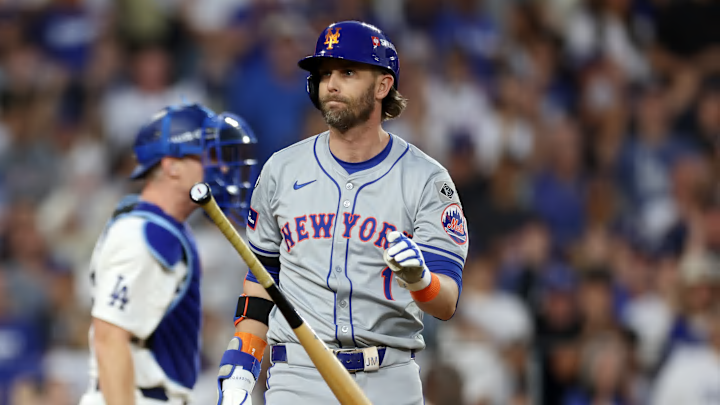After an offseason packed with big moves, the New York Mets have finally answered Bud Abbott’s timeless question: “Who’s playing first?” Met fans are still basking in the glow of Pete Alonso’s $54 million deal, a savvy play by David Stearns that keeps the Polar Bear in Queens. While the contract solidifies the corner infield positions, it now shines a spotlight on second base, where uncertainty is creeping in. The crank has been turned, the green boot has kicked the marble, and when that little figure does its backflip, Jeff McNeil might find himself trapped under the falling cage.
Rarely does a veteran with a .289 career average, .353 OBP, and a 117 OPS+ enter spring training with as much to prove as Jeff McNeil. Over seven seasons, he’s been the ultimate team player—plugging holes all over the field, hitting in every spot in the order, and doing whatever the Mets have asked. But numbers don’t lie. His offensive production has dipped over the last two seasons, the injuries are piling up, and at 32, he’s not getting any younger. No matter how you slice it, McNeil heads into 2025 with a target on his back and a lot to prove.
The past two Septembers haven’t been kind to McNeil, as elbow and wrist injuries cut both seasons short. But it’s what he did before those injuries that have everyone talking—and not in a good way. Since his 2022 All-Star campaign, his numbers have taken a nosedive. His batting average has dropped 88 points to .238, his OBP has fallen 74 points to .308, and his OPS has plummeted 144 points to .692 (all 2024 numbers). Even more troubling? His struggles with runners in scoring position. Last season, he hit just .208 in those spots with a .721 OPS, and 29% of his total strikeouts came in those crucial at-bats. With younger competition knocking at the door, McNeil is running out of room for error.
With the corner infield spots secured, the NY Mets could see prospects like Luisangel Acuña start pushing Jeff McNeil for playing time at second base.
Many believe Acuña is destined for the Mets’ fourth bench spot to start the season, but don’t be surprised if he forces his way into a bigger role. His stint in Syracuse last year was underwhelming, but when he got the call to Queens in September, he made the most of it—hitting .308 with a .966 OPS and six extra-base hits over 39 at-bats. He kept that momentum rolling in winter ball, slashing .337 with a .914 OPS and nine extra-base hits in 101 at-bats. But the real game-changer? His speed. Since 2022, Acuña has racked up 137 stolen bases at an 81% success rate.
The Mets' bottom-of-the-lineup needs fresh energy and excitement, and McNeil has to prove he can bring that once again. While he’s been dependable in the past, his recent decline in performance leaves much to be desired. If he can’t step up, prospects like Acuña are ready to seize the opportunity. With his speed and enthusiasm, Acuña brings the kind of youthful spark Mets fans loved watching from Vientos last year. Spring training and the start of the season will be crucial for McNeil—if he doesn’t show he can still be a difference-maker, the Mets may have no choice but to hand the reins over to the next generation.
